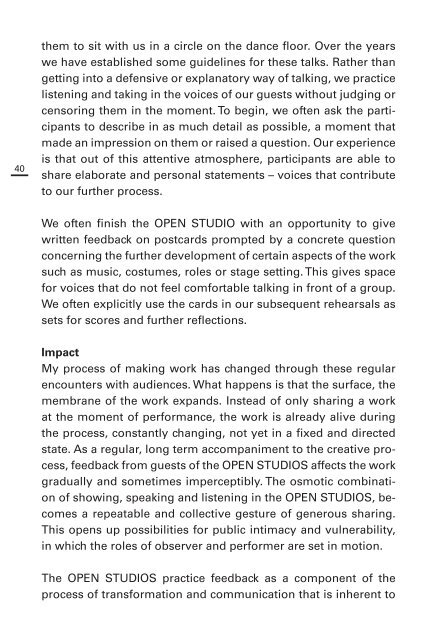Laboratory on Feedback in Artistic Processes 3
In its third edition the "Laboratory on Feedback in Artistic Processes" reflects on "Responses" within performing arts. The results of the previous Labs highlighted the need to take a closer look at the complexity and often subtle implications of feedback within the the artistic process itself. How do artist organise feedback and how do they process it? Who they want feedback from and what are its different roles? How can describe these relationships, and how does it shpae the artistic work? This booklet presents the different views on and experiences of feedback practices that were elaborated during the lab along the beforementioned questions and the insightfull contributions of its participants. Underpinning the following pages, three thematic fields have emerged: the impacts of feedback, feedback as a tool, and practicalities and contexts of feedback.
In its third edition the "Laboratory on Feedback in Artistic Processes" reflects on "Responses" within performing arts. The results of the previous Labs highlighted the need to take a closer look at the complexity and often subtle implications of feedback within the the artistic process itself. How do artist organise feedback and how do they process it? Who they want feedback from and what are its different roles? How can describe these relationships, and how does it shpae the artistic work?
This booklet presents the different views on and experiences of feedback practices that were elaborated during the lab along the beforementioned questions and the insightfull contributions of its participants. Underpinning the following pages, three thematic fields have emerged: the impacts of feedback, feedback as a tool, and practicalities and contexts of feedback.
Create successful ePaper yourself
Turn your PDF publications into a flip-book with our unique Google optimized e-Paper software.
40<br />
them to sit with us <strong>in</strong> a circle <strong>on</strong> the dance floor. Over the years<br />
we have established some guidel<strong>in</strong>es for these talks. Rather than<br />
gett<strong>in</strong>g <strong>in</strong>to a defensive or explanatory way of talk<strong>in</strong>g, we practice<br />
listen<strong>in</strong>g and tak<strong>in</strong>g <strong>in</strong> the voices of our guests without judg<strong>in</strong>g or<br />
censor<strong>in</strong>g them <strong>in</strong> the moment. To beg<strong>in</strong>, we often ask the participants<br />
to describe <strong>in</strong> as much detail as possible, a moment that<br />
made an impressi<strong>on</strong> <strong>on</strong> them or raised a questi<strong>on</strong>. Our experience<br />
is that out of this attentive atmosphere, participants are able to<br />
share elaborate and pers<strong>on</strong>al statements – voices that c<strong>on</strong>tribute<br />
to our further process.<br />
We often f<strong>in</strong>ish the OPEN STUDIO with an opportunity to give<br />
written feedback <strong>on</strong> postcards prompted by a c<strong>on</strong>crete questi<strong>on</strong><br />
c<strong>on</strong>cern<strong>in</strong>g the further development of certa<strong>in</strong> aspects of the work<br />
such as music, costumes, roles or stage sett<strong>in</strong>g. This gives space<br />
for voices that do not feel comfortable talk<strong>in</strong>g <strong>in</strong> fr<strong>on</strong>t of a group.<br />
We often explicitly use the cards <strong>in</strong> our subsequent rehearsals as<br />
sets for scores and further reflecti<strong>on</strong>s.<br />
Impact<br />
My process of mak<strong>in</strong>g work has changed through these regular<br />
encounters with audiences. What happens is that the surface, the<br />
membrane of the work expands. Instead of <strong>on</strong>ly shar<strong>in</strong>g a work<br />
at the moment of performance, the work is already alive dur<strong>in</strong>g<br />
the process, c<strong>on</strong>stantly chang<strong>in</strong>g, not yet <strong>in</strong> a fixed and directed<br />
state. As a regular, l<strong>on</strong>g term accompaniment to the creative process,<br />
feedback from guests of the OPEN STUDIOS affects the work<br />
gradually and sometimes imperceptibly. The osmotic comb<strong>in</strong>ati<strong>on</strong><br />
of show<strong>in</strong>g, speak<strong>in</strong>g and listen<strong>in</strong>g <strong>in</strong> the OPEN STUDIOS, becomes<br />
a repeatable and collective gesture of generous shar<strong>in</strong>g.<br />
This opens up possibilities for public <strong>in</strong>timacy and vulnerability,<br />
<strong>in</strong> which the roles of observer and performer are set <strong>in</strong> moti<strong>on</strong>.<br />
The OPEN STUDIOS practice feedback as a comp<strong>on</strong>ent of the<br />
process of transformati<strong>on</strong> and communicati<strong>on</strong> that is <strong>in</strong>herent to


















